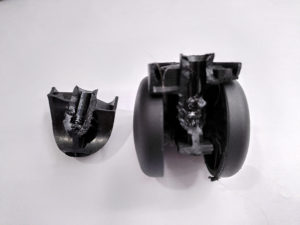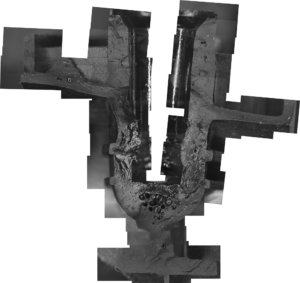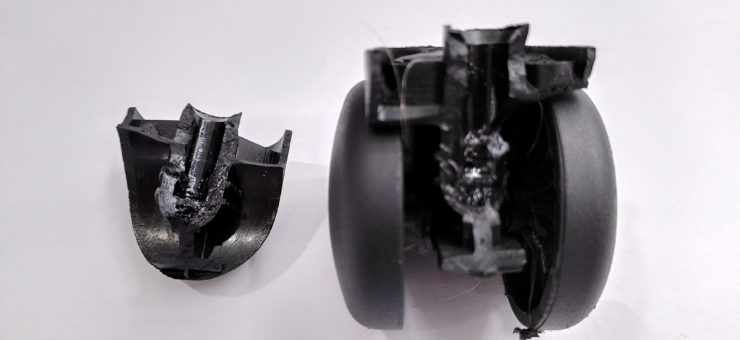Mapping the fracture surface of an injection molded part
4 March 2024
Recently we had a wheel break off an office chair. Unlike many of our clients, we at Springboard get very excited when things break, because it usually means there’s an interesting problem to be solved. We took a few hours to map the fracture surface, and gather opinions from a few engineers and materials scientists around the office.
The first thing to note is that this is a brittle failure. There is no sign of large-scale plasticity: the two parts fit back together perfectly, and there is no stress whitening of the black-coloured plastic.
Looking at the fracture surface by eye the most obvious features are the many voids at the intersection of the bore and rib. This is a common defect in injection molding caused by shrinkage of the polymer melt in that thicker section, and can be designed out by reducing the thickness.

Chair wheel fracture
Another interesting feature is that some of the fracture surface is dull, but most of it is quite shiny. Closer examination of the shiny areas under a microscope shows a smooth, rippled surface texture, like freshly poured molten toffee – not usual for a fracture surface. We think it is the weld line: when plastic fills a mold, the surface where two flows meet doesn’t always fuse together properly, and presents a line of weakness. The position of the gates (where plastic is injected into the mold) is consistent with this. In this case, it seems that a crack started, and subsequently found its way into this pre-existing weak surface.

Detailed close up of the fracture surface viewed using a CMM machine
Looking closer at the dull part of the fracture surface reveals river marks, which point back to the origin of the crack. Piecing the component back together reveals that there is indeed a stress concentration at that point. Microscopic examination of the origin shows sign of none of the characteristics of fatigue crack initiation: beach marks, or micro-plasticity. We can therefore conclude that the chair was simply not strong enough to support a well-fed engineer!
Get in touch today if you have a tricky obstacle that is hampering your development.
Investigated and written by Omar Shah


